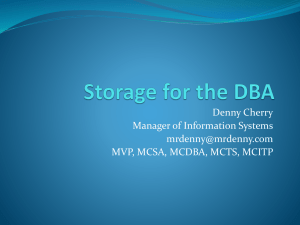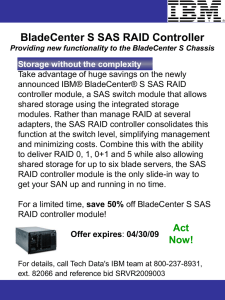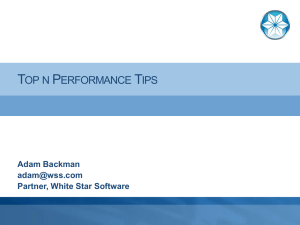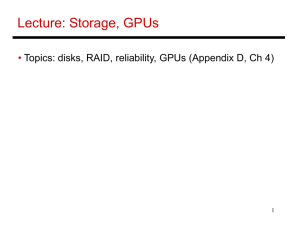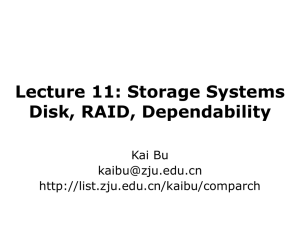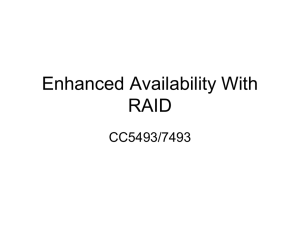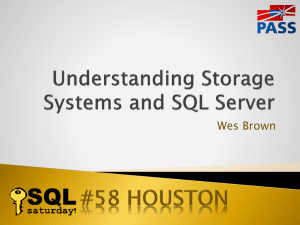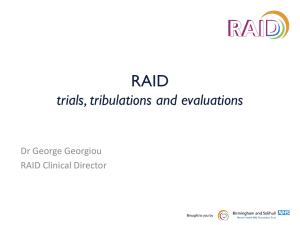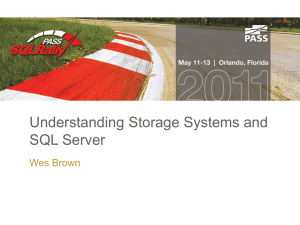Database Storage for Dummies
advertisement
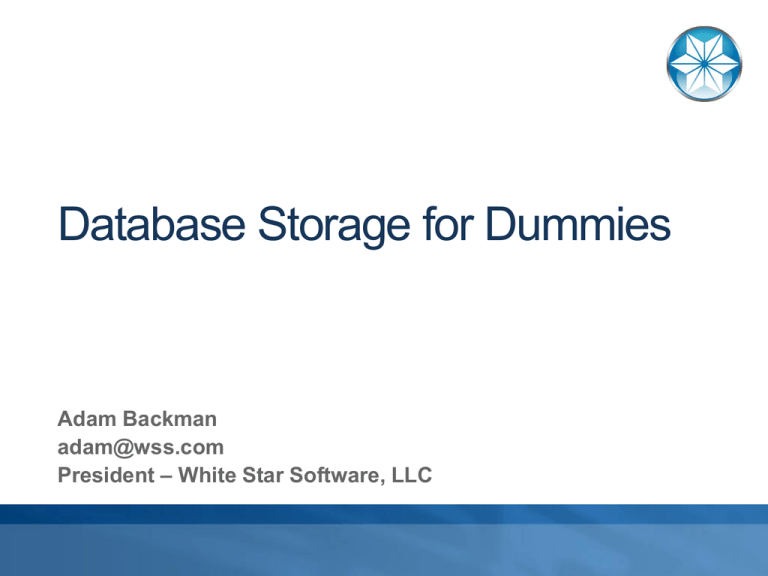
Database Storage for Dummies Adam Backman adam@wss.com President – White Star Software, LLC Introduction Why is database storage important? OpenEdge considerations What is RAID? Hardware vs. Software RAID How to buy disk capacity Hardware options Wrap up About the speaker President – White Star Software − Serving the Progress community since 1985 − Consulting Application support (design, build, review, …) Administration (Database, operating system, storage) − Training (Application and administration) Vice President – DBAppraise − Simplifying the task of monitoring and managing the worlds best business applications − Remote management of your OpenEdge environment by the worlds best OpenEdge administrators Why is storage so important? Storage Goals − Reliability Protection of your data from data loss − Availability Data is available to the users − Performance Uniform application response time under varying workloads These different goals tend to work against each other Why is storage so important? Everything starts on the disk When tuning, it is the second most likely cause for performance issues after application code Disk is an order of magnitude slower than memory Performance tuning is a process of pushing the bottleneck to the fastest resource Network Disk Memory CPU OpenEdge Considerations Type II storage area Database block size Records per block Before image cluster size After image I/O Records Type I Storage Areas Data blocks are social − They allow data from any table in the area to be stored within a single block − Index blocks only contain data for a single index Data and index blocks can be tightly interleaved potentially causing scatter Database Blocks Fixed extent Cluster Database block Variable extent Not yet allocated by O/S Filled Partly filled Free Not yet allocated Type II Storage Areas Data is clustered Clustering improves performance − Better proximity of data − Less disk head movement − Able to take advantage of read ahead algorithms Performance increase has been tested and proven to be (nearly) universal Dump and load or table/index move required to move from type I to type II areas Type II Storage Areas Data is clustered together A cluster will only contain records from a single table A cluster can contain 8, 64 or 512 blocks This helps performance as data scatter is reduced Disk arrays have a feature called read-ahead that really improves efficiency with type II areas Type II Clusters Fixed Extent Cluster Customer Cluster Order Cluster Order Line Storage Areas Compared Type I Type II Data Block Data Block Index Block Data Block Data Block Data Block Index Block Index Block Data Block Index Block Data Block Data Block Data Block Data Block Data Block Data Block Data Block Data Block Index Block Index Block Cluster Importance of database block size OpenEdge® default block size is still 1kb Larger block allow for more records or index entries per physical operation Matching operating system and database block sizes improves efficiency − Generally 8k block size is best for most − 4k is best for Windows servers Larger blocks *may* require a higher records per block setting Records per block setting Each area can have a different setting Default is 64, this is generally too low for 8k blocks Calculation: Database-block-size/(Mean-record-size + 20) = Maximum-Rec/block 20 is the approximate overhead per record Records per block setting should equal the next HIGHER binary number between 1 and 256 Set too low and you waste space and reduce the efficiency of every read operation Set too high and run the risk of record fragmentation Example: Records /Block Mean record size = 90 Add 20 bytes for overhead (90 + 20 = 110) Divide product into database blocksize Example: 8192 ÷ 110 = 74.47 Choose next higher binary number 128 Default records per block is 64 Before Image Cluster Size One the best ways to improve OLTP performance Default has been increased to 512k but in most cases a setting above 4096k (4MB) is more appropriate BI cluster size determines the amount of transactional (create, update, delete) work that is done between checkpoints The goal is to have 120 seconds between checkpoints at you busiest update time of the day After Image affect on I/O decisions After Imaging provides an extra level of data protection in case of media loss Everyone should be using after imaging After image files should be isolated from the rest of the database − Best case: different physical hardware − Usual scenario: Different file system Writes to this file have the potential to be expensive What RAID really means Most commonly used RAID levels: RAID 0: This level is also called striping. RAID 1: This is referred to as mirroring. RAID 5: Most controversial RAID level RAID 10: This is mirroring and striping. Also known as RAID 0 + 1 (OpenEdge preferred) Raid 0: Striping Disk 1 Stripes 1, 4, … Disk 2 Stripes 2, 5, … Stripe 1 Stripe 2 Stripe 3 Stripe 4 ... Disk 3 Stripes 3, 6, … Volume Group Disk Array RAID 0: Striping (cont.) Good for read and write I/O performance No failover protection lower data reliability (1 fails they all fail) What is Stripe Width? Also called chunk size Stripe width is the amount of data put on a physical volume before moving to the next disk in the set 128k is a good stripe width for 8k block size databases but performance has been proven to increase with even larger stripe widths (upto and including 2MB tested) RAID 1: Mirroring Disk 1 Disk 2 Primary Parity 1 Parity 2 Parity RAID 1: Mirroring (cont.) OK for read and write applications Good failover protection High data reliability Most expensive in terms of hardware RAID 5: Poor man’s mirroring User information is striped Parity information is striped with user info − Write primary data − Calculate parity − Write parity Good for read intensive applications Poor performance for writes after cache is exhausted Single disk failure is protected but performance will suffer RAID 10: Mirroring and Striping Ideal for both read, write or mixed applications High level of data reliability though not as high as RAID 1 due to striping Just as expensive as RAID 1 Generally, the recommended RAID level for most OpenEdge applications RAID 10 vs. RAID 5 cache fill rate fillTime = cacheSize / (requestRate – serviceRate) • 4 disks • RAID10 vs RAID5 • 4KB db blocks • 4GB RAM cache (1048576 blocks) Typical Production DB Example: 4GB / ( 200 io/sec – 800 io/sec ) = cache doesn’t fill! Heavy Update Production DB Example: 4GB / ( 1200 io/sec – 800 io/sec ) = 2621 sec. (≈ 44 min.) (RAID10) 4GB / ( 1200 io/sec – 200 io/sec ) = 1049 sec. (≈ 17 min.) (RAID5) Maintenance Example: 4GB / ( 5000 io/sec – 3200 io/sec ) = 583 sec. (≈ 10 min.) (RAID10) 4GB / ( 5000 io/sec – 200 io/sec ) = 218 sec (≈ 4 min.) (RAID5) Hardware vs. Software RAID Software RAID − Uses primary CPU resources − Less scalable − Generally less expensive Hardware RAID − − − − The preferred option Dedicated resources (memory and CPU) for storage Much greater scalability More expensive up front but you pay once and reap the benefits for the life of the hardware Buying Disks Buy small disks (individual drives) Each disk regardless of it’s size is capable of doing approximately the same number of I/Os per second Buy fast disks Slow disk = slow performance Buy reliable disks Buy many disks The outer portion of the disk is up to 20% faster than the inner portion of the disk Try to leave room for inexpensive growth − Upgrades tend to be more expensive Buying Disk Arrays Considerations Include: Reliability Features (remote mirroring, software, …) Storage capacity Throughput capacity Support capacity Replacement/upgrade path Hardware options Many excellent options for all size operations Small to medium scale − iSCSI − Low cost − General availability components (SAS, SCSI, non-fibre channel) Medium to large scale − SAN − mid-range cost (fibre channel drives, Switches, …) − Good scalability Enterprise scale − Fibre throughout the array − Nearly unlimited scalability Hardware Examples – Architecture Direct Attached Storage − SAS and SATA drives − No dedicated array cache − Single path iSCSI − SAS, SATA and fibre channel drives − Limited array cache − Multi-path SAN − Fibre channel drives − Multi-path throughout the array Network Attached Storage (NAS) The most well known NAS company is NetApp NAS devices are great for file storage NetApp even calls their device a “filer” These are NOT good devices for databases due to the file vs. block nature of the storage Hardware options – Upgrade Path Few people consider the replacement of their storage when first making the array purchase Replacement is still the way that most small to medium size systems are upgraded In-place upgrades are that require downtime or reconfiguration are the hallmark of midrange arrays Zero downtime in-place upgrades are now the norm in enterprise arrays. Hardware Examples Equilogic – Great availability, reasonable pricing EMC VNXe – Lower end EMC versus VMAX HP EVA – Super ease of use, self tuning Hitachi Data Systems – Ultra scalable IBM XIV – Commodity hardware, enterprise features FusionIO – Ultra fast but VERY expensive and mostly unproven technology Points to Remember Disks are a good place to put money in the hardware acquisition process Take advantage by optimizing your database storage − − − − Type II Database block size BI cluster size Isolating After Image extents Buy what you need but remember that you may need to upgrade so buy with growth in mind People generally overbuy CPU capacity and under buy disk throughput capacity Questions Thank you for your time!
